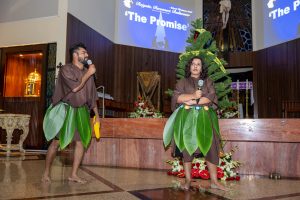It may be shocking to hear this, but for many Catholics, the Bible is an ornamental piece, placed on the family altar, never read, and collecting dust. A large part of this is that Catholics take for granted that they will eventually at some point in time during the Eucharistic Celebration, hear the Word of God being proclaimed to them. In addition, there is also a general ignorance about the very doctrines of our faith that stems from a misconception that only Protestants love the bible – based on the fallacy of Sola Scriptura – that the Bible is the only authority with regards to teachings about the Faith. Without deviating too much into an apologetic explanation of why Sola Scriptura does not hold water, Sola Scriptura is not what the Apostles taught, nor is it found in the Scriptures itself. The Word of God also comprises of proclaimed oral teachings for example, as Jeremiah 25:3 says, “the word of the Lord has come to me and I have spoken to you again and again…” These oral utterances were later codified into the written word. Jesus and St. Paul also accepted and defended Traditions that had been handed down – For example, the reference, “He shall be called a Nazarene”, is not found in the Old Testament, but spoken by the prophets (cf. Matthew 2: 23) (Nash, n.d.; Armstrong, 2004).
The Catechism of the Catholic Church states, that the Gospel was handed on in two ways: 1) orally – by the spoken word of the Apostles and by their example and way that they lived, 2) in written forms by those who were inspired by the Holy Spirit to record and document in the written word, the teachings that had been handed down (CCC. 76).
The following points expound on how there is fidelity in apostolic succession, and how the Church ensures that each subsequent generation receives the Truths of the Catholic Church in their fullness:
77 “In order that the full and living Gospel might always be preserved in the Church the apostles left bishops as their successors. They gave them their own position of teaching authority.” Indeed, “the apostolic preaching, which is expressed in a special way in the inspired books, was to be preserved in a continuous line of succession until the end of time.”
78 This living transmission, accomplished in the Holy Spirit, is called Tradition, since it is distinct from Sacred Scripture, though closely connected to it. Through Tradition, “the Church, in her doctrine, life and worship, perpetuates and transmits to every generation all that she herself is, all that she believes.” “The sayings of the holy Fathers are a witness to the life-giving presence of this Tradition, showing how its riches are poured out in the practice and life of the Church, in her belief and her prayer.”
79 The Father’s self-communication made through his Word in the Holy Spirit, remains present and active in the Church: “God, who spoke in the past, continues to converse with the Spouse of his beloved Son. And the Holy Spirit, through whom the living voice of the Gospel rings out in the Church – and through her in the world – leads believers to the full truth, and makes the Word of Christ dwell in them in all its richness.”
(CCC. 77-79)
Sacred Tradition and Sacred Scripture are thus so intricately interwoven with each other, that each communicates and informs the other, and each cannot do without the other. These then form the living and dynamic Deposit of Faith that is handed down in the Church (CCC. 80).
The invitation thus is for Catholics to truly take up the Bible and read it, worship and pray with it, and allow God to speak to us through it.
The Bible is a collection of books that includes History and Fact, Poetry, Prophecies, Proverbs and Wisdom sayings, Letters and Epistles, and Allegories that teach of a greater Truth about God. While the Bible contains many stories – the narrative is constant. There is in essence only one story running through, and this is the story about how God our Father, created all things, created Man, and how God our Father constantly reaches out in love to Man, to the extent of giving His Son to us in death, despite uncountable betrayals. In Salvation History – God our Father makes covenantal promises to Man so as to draw him into Himself – the Communion of the Holy Trinity (Cavins, 2020).
From the beginning, it was God’s intention to walk with Man and for Man to know deeply the love of God. Man was to be set apart as holy, and belonging to God’s family, tribe, nation, and kingdom (Cavins, 2020). The sin that Adam and Eve committed was disobedience, and this First Sin, was the catalyst in breaking people away from being in a relationship with God. The fall of Adam and Eve resulted in shame, but the Lord God, continued his Edenic covenant by clothing them, providing for them, and protecting them. In the Edenic covenant, marriage, as a foretaste of the Church’s marriage with Christ our heavenly Bridegroom in heaven, is the sign of this covenant.

Adam and Eve in the Garden of Eden
Forward some generations, the world is shrouded with sinfulness and the LORD GOD makes the difficult decision to complete the work of destruction that human beings had started (cf. Genesis 6:3). However, as the story goes, Noah is found righteous, and the LORD GOD decides to spare him by instructing him to build an ark. When the rains begin to fall, Noah having built the ark according to the divine instructions given by God, enters the ark. The LORD GOD closes the door of the ark and keeps the people and living creatures inside this ark safe from the destruction that rages about outside. When the waters recede and Noah and living creatures step out on to dry land, the LORD GOD makes a covenant with Noah, with the covenantal sign of a rainbow – that He would never again destroy the world through such means as a flood (CCC. 56-58; Campbell, n.d.). The Noahic Covenant is important, because it shows us that in spite of our multitudinous sins, God our Father still desires to save humankind.

Abraham intercedes for the People
The Abrahamic Covenant can be defined as having three parts – first, God desires to make a great nation out of Abraham (cf. Genesis 12:1-2); second, God desires to give Abraham a great name (cf. Genesis 12:2); and third, God desires to make Abraham a source of immense blessing to the world (cf. Genesis 12:3) (St. Paul Center for Biblical Theology, n.d.). In this covenant, the sign is to be that of circumcision – signifying that these were now a people set apart from the rest of humanity, and to enact the covenant, Abraham had to take on a new name and leave his home to enter into a new land that the LORD GOD had already set apart for him. Interestingly, the Abrahamic Covenant Points the way to the future of Salvation – 1) The Great Nation, a Royal Dynasty comes into being during the Exodus (Genesis 46: 3-4); 2) The Great Name is fulfilled in the future Kingship of King David (2 Samuel 7:9); 3) The Blessing of future generations is fulfilled in Jesus. This is why the first sentence of the New Testament opens with the words, “The book of the genealogy of Jesus Christ, the son of David, the son of Abraham.” (Matthew 1: 1)

Moses receives the Ten Commandments on Mt. Sinai
With Moses during the time of the Exodus, the LORD GOD establishes a covenant to enact a Kingdom of Priests. This covenant signifies that the Lord’s people have been set free from slavery, and now are God’s own people, who have been chosen and set apart by God. The sign of this covenant is represented by the Passover (St. Paul Center for Biblical Theology, n.d.b). A point of note, however, is that while the Abrahamic Covenant was lasting and enduring, the Mosaic Covenant is provisional and intervening – a transient stage in the decrees of the law, where upon which entering into its pedagogical goal – Jesus, the Mosaic law falls away, the new Law is then perfected and made permanent in Jesus (Ratzinger, 1995).
The next covenant that God makes with His people, is the Davidic Covenant. David is established as King. When this happens, David has in his mind a thought to build a house for God, but God in his sense of humour tells David clearly that it is in fact the LORD GOD, who will build and establish the house of David – a dynasty where his descendants will sit on the throne and their rule would last forever. Unlike Saul, David’s kingship is not removed from him (2 Samuel 7). In the Davidic Covenant – seen to fruition in Solomon, we see the qualities that God envisions for his family on Earth – where the people bring God a sacrifice of thanksgiving – “For You are not pleased with sacrifices, should I offer a holocaust, You would not accept it. My sacrifice, O my God, is a contrite spirit, a heart contrite and humbled” (Psalm 51:18-19); “Sacrifice or oblation You wished not, but ears open to obedience… Holocausts and sin-offerings You sought not….To do Your will, O my God, is my delight, and Your Law is within my heart!” (Psalm 40:7-9). The sign of this covenant is the temple (St. Paul Center for Biblical Theology, n.d.c)

Eli is woken up by Samuel

Goliath flexes

David had no chill

The breath of God, brought to life these dry bones
The new covenant by God our Father is promised in the time of Jeremiah (Jeremiah 31: 31-34) and comes to fulfilment in Jesus (Luke 22:20). This new covenant is found in the institution of the Eucharist and the Precious Blood of Jesus – “He said to them, “This is my blood of the covenant, which will be shed for many.” (Mark 14: 24). The blood of this New Covenant is a reference to ancient rite described in Exodus 24: 4-8 and also indicates the new community that the sacrifice of Jesus will bring into being (Matthew 26:26–28; Luke 22:19–20; 1 Corinthians 11:23–25). The Eucharist is thus the covenantal sign for this covenant. It is the Blood of Christ that will establish the kinship between God and Humanity. Why do we find in Jesus the perfect fulfilment of the covenants of God? Jesus is the New Adam, restoring what was broken in the Garden of Eden through a new creation. Jesus brings a new type of flood – one that does not destroy, but gives life in the living waters of Baptism. In Jesus, all the nations find blessing, and in Jesus, we are given a new Passover – the Eucharist. Christ’s kingdom never ends, and His Kingdom is established forever (St. Paul Center for Biblical Theology, n.d.d; Grondin, n.d.)
These covenants were not a result of God being obliged to make covenants with people, but come from a place of God truly loving His people. These covenants are proof that God never gives up on His people. In these covenants we see God the Father taking care of His children through binding oaths – there is an exchange not of goods, but of persons, and in this exchange, God reaches out for humanity, calls the wayward child back, and fathers us. While we may break these covenants, God our Father proves His steadfastness, fidelity, and faithfulness to these covenants (Pizzalato, n.d.).
Returning back to Scripture is an awesome way of reading God our Father’s love letters to His children. In Scripture, we see the documentational and irrefutable proof that we are indeed beloved by God our Father. This love is enacted out through His covenants, and tells us that His promises endure forever.
By the Grace of God,
Brian Bartholomew Tan
(Images contributed by Mervyn Wong)
References
Armstrong, D. (2004). A Quick Ten-Step Refutation of Sola Scriptura. Catholic Answers. Retrieved January 12, 2023 from https://www.catholic.com/magazine/print-edition/a-quick-ten-step-refutation-of-sola-scriptura
Campbell, J. (n.d.). Noah and the Flood. Loyola Press. Retrieved January 12, 2023 from https://www.loyolapress.com/catholic-resources/scripture-and-tradition/scripture/noah-and-the-flood/
Catechism of the Catholic Church. (1993). Libreria Editrice Vaticana. Retrieved from https://www.vatican.va/archive/ENG0015/_INDEX.HTM
Cavins, J. (2020). God’s Story Is Your Story, Part 4: Salvation History. Ascension Press. Retrieved January 12, 2023 from https://media.ascensionpress.com/2020/08/23/story-story-part-4/
Grondins, C. (n.d.). How many Covenants Are there in the Bible? Catholic Answers. Retrieved January 12, 2023 from https://www.catholic.com/qa/how-many-covenants-are-there-in-the-bible
Nash, T. (n.d.). “He shall be called a Nazarene:” Where in Old Testament? Catholic Answers. Retrieved January 12, 2023, from https://www.catholic.com/qa/he-shall-be-called-a-nazarene-where-in-old-testament
Pizzalato, B. (n.d.). Covenants, sacraments divinely linked. Catholic News Agency. Retrieved January 12, 2023 from https://www.catholicnewsagency.com/resource/55678/covenant-sacraments-divinely-linked
Ratzinger, Cardinal, J. (1995). The New Covenant: A Theology of Covenant in the New Testament. Communio: International Catholic Review 22(4). 635-651.
St. Paul Center for Biblical Theology. (n.d.) God’s Covenant Plan, Lesson 3.3.. Retrieved January 12, 2023 fromhttps://stpaulcenter.com/gods-covenant-plan-lesson-3-3/
St. Paul Center for Biblical Theology. (n.d.b) Blood of the Covenant: Scott Hahn Reflects on Corpus Christi. Retrieved January 12, 2023 from https://stpaulcenter.com/audio/sunday-bible-reflections/blood-of-the-covenant-scott-hahn-reflects-on-corpus-christi/
St. Paul Center for Biblical Theology. (n.d.c) Covenant Love, Lesson 5.5. Retrieved January 12, 2023 from https://stpaulcenter.com/covenant-love-lesson-5-5/
St. Paul Center for Biblical Theology. (n.d.d.) Covenant Love, Lesson 6.1. Retrieved January 12, 2023 from https://stpaulcenter.com/covenant-love-lesson-6-1/

